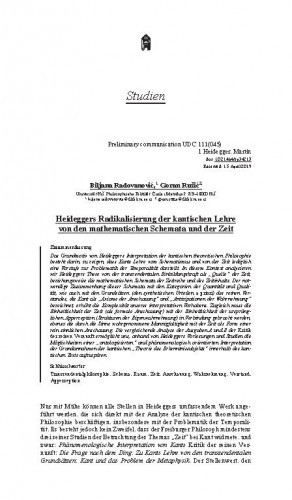Das Grundmotiv von Heideggers Interpretation der kantischen theoretischen Philosophie besteht darin, zu zeigen, dass Kants Lehre vom Schematismus und von der Zeit lediglich eine Vorstufe zur Problematik der Temporalität darstellt. In diesem Kontext analysieren wir Heideggers These von der transzendentalen Einbildungskraft als „Quelle“ der Zeit, beziehungsweise die mathematischen Schemata der Zeitreihe und des Zeitinhalts. Der notwendige Zusammenhang dieser Schemata mit den Kategorien der Quantität und Qualität, wie auch mit den Grundsätzen (den synthetischen Urteilen a priori) des reinen Verstandes, die Kant als „Axiome der Anschauung“ und „Antizipationen der Wahrnehmung“ bezeichnet, erhöht die Komplexität unseres interpretativen Vorhabens. Zugleich muss die Einheitlichkeit der Zeit (als formale Anschauung) mit der Einheitlichkeit der ursprünglichen Apperzeption (Strukturen der Eigenwahrnehmung) in Verbindung gebracht werden, ebenso die durch die Sinne wahrgenommene Mannigfaltigkeit mit der Zeit als Form einer rein sinnlichen Anschauung. Die vergleichende Analyse der Ausgaben A und B der Kritik der reinen Vernunft ermöglicht uns, anhand von Heideggers Vorlesungen und Studien die Möglichkeiten einer „ontologisierten“ und phänomenologisch orientierten Interpretation der Grundannahmen der kantischen „Theorie des Erkenntnissubjekts“ innerhalb des kantischen Texts aufzuspüren.; Osnovni motiv Heideggerova tumačenja Kantove teorijske filozofije sastoji se u tome da se pokaže da Kantovo učenje o shematizmu i vremenu predstavlja tek pred-stupanj problematike temporalnosti. U tom kontekstu analizirat ćemo Heideggerovu tezu o transcendentalnoj uobrazilji kao »izvoru« vremena, odnosno matematičke sheme vremenskog niza i vremenskog sadržaja. S obzirom na to da su ove sheme nužnim načinom povezane s kategorijama kvantitete i kvalitete, kao i s načelima (sintetičkim stavovima a priori) čistog razuma koja je Kant formulirao kao »aksiome zrenja« i »anticipacije opažaja«, jasno je da je time naš interpretativni zadatak postao složeniji. Paralelno s navedenim, morali smo dovesti u vezu jedinstvo vremena (kao formalnog zora) s jedinstvom praosnovne apercepcije (strukture samosvijesti), kao i čulno danu mnogostrukost s vremenom kao formom čistog čulnog zora. Usporedna analiza A i B izdanja Kantove Kritike čistog uma omogućila nam je, preko Heideggerovih predavanja i studija, da unutar Kantova teksta sagledamo mogućnosti »ontologizirane« i fenomenološki usmjerene interpretacije i tumačenja osnovnih postavki Kantove »teorije spoznajnog subjekta«.; The basic motive of Heidegger’s interpretation of Kant’s theoretical philosophy consists of an intention to show that Kant’s teaching on schematism and time represents a pre-phase of the problem of temporality. In that context, we will analyse Heidegger’s thesis on transcendental imagination as the “source” of time, that is, of the mathematical schemata of the timeline and the content of time. Considering that these schemata are by necessity connected to the categories of quantity and quality, as well as with principles (synthetic judgments a priori) of pure reason, which Kant formulated as the “axioms of intuition” and “anticipation of perception”, it is clear that this makes our interpretative task more complicated. In parallel, we had to make a connection between the unity of time (as formal intuition) and the unity of fundamental aperception (structure of consciousness), as well as the perceptual multiplicity with the time as the pure form of intuition. Comparative analysis of A and B editions of Kant’s Critique of Pure Reason allowed us to, by using Heidegger’s lectures and studies, consider within Kant’s text the possibility of “ontologised” and phenomenologically focused interpretation of fundamental assumptions of Kant’s “theory of knowing subject”.; La raison principale de l’interprétation heideggérienne de la théorie philosophique de Kant réside dans l’intention de montrer que l’enseignement kantien sur le schématisme et le temps ne présente qu’un pré-niveau de la problématique de la temporalité. Dans ce contexte, nous analyserons la thèse heideggérienne de l’imagination transcendantale en tant que la « source » du temps, à savoir les schèmes mathématiques de la succession temporelle et du contenu temporel. Étant donné que ces schèmes sont de manière nécessaire liées aux catégories de la quantité et de la qualité, autant qu’elles le sont aux principes (à travers les jugements synthétiques a priori) de la raison pure que Kant formule en tant qu’ « axiomes de l’intuition » et « anticipations de la perception », il est clair qu’ainsi notre devoir d’interprétation est devenu plus complexe. En parallèle avec ce qui vient d’être mentionné, nous avons été contraints de mettre en lien l’unité du temps (en tant qu’intuition formelle) avec l’unité originelle de l’aperception (structures de la conscience de soi), mais également la multiplicité du donné sensible avec le temps et la forme de l’intuition pure sensible. L’analyse comparative des éditions A et B de la Critique de la raison pure nous a permis, à travers les cours et les études de Heidegger, de considérer à l’intérieur des textes kantiens les possibilités pour une interprétation à tendance « ontologiseante » et phé- noménologique, et d’interpréter les données principales « de la théorie du sujet connaissant ».
Sažetak

 Synthesis philosophica : 34,2(2019) / editor-in-chief Ante Čović.
Synthesis philosophica : 34,2(2019) / editor-in-chief Ante Čović.